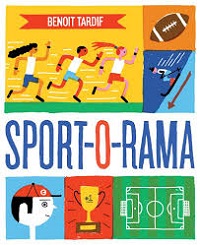| ________________
CM . . .
. Volume XXI Number . . . .June 19, 2015
excerpt:
Though the publisher claims that this illustrated wordbook targets audiences from PreK to Grade 2, some of the humour will be lost on that age group, and the descriptions of the sports at the back of the book include vocabulary that is too difficult for the intended audience. Just from looking at the drawings, readers will have no idea how the sport is played, and there are several drawings which require either prior knowledge of the sport (e.g. what purpose do the red and yellow cards in soccer serve?) or an adult or older child reading the book with the younger child. It is doubtful that readers will understand what a peloton is (in cycling) or a metal plastron (in fencing) just from the drawing. In games that are often played in doubles, such as tennis and badminton, teams are not shown, and the lines for double play on the court are not labelled. In the section on golf, why is the “tired player” the one riding in the cart (if this is an attempt at subtle humour on the part of the author, it will, most surely, be lost on the young audience). But the most disturbing drawing appears on the diving page. It shows three divers, each one leaping from a different tower height. If this were actually to happen in real life, where all three participants dived at the same time, it would potentially lead to catastrophic results. Though the book has many merits – humour, cute drawings that will appeal to very young readers, and clever ways to showcase the featured sports – some of which will be new to kids – readers, having read the book, will still be no further ahead on knowing how the game is played or scored. Too juvenile in its style of illustration and the inclusion of the Halftime activity to suit older readers, but too sophisticated in some of the terminology and the lack of clarity for younger readers, this wordbook is kind of between worlds. Recommended with Reservations.
Gail Hamilton is a former teacher-librarian in Winnipeg, MB.
To comment on this title or this review, send mail to cm@umanitoba.ca.
Copyright © the Manitoba Library Association. Reproduction for personal use is permitted only if this copyright notice is maintained. Any
other reproduction is prohibited without permission.
CM Home |
Next Review |
(Table of Contents for This Issue - June 19, 2015.)
| Back Issues | Search | CM Archive
| Profiles Archive |
